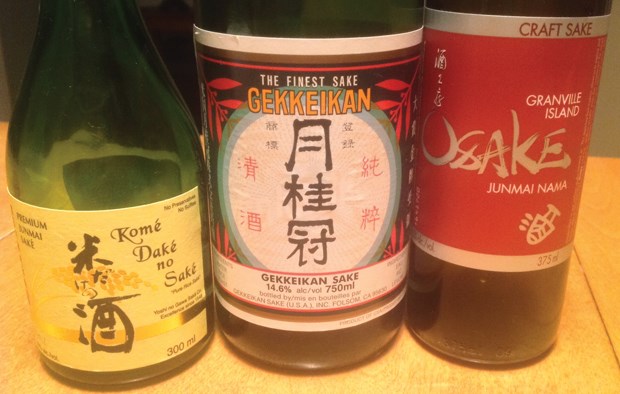With the proliferation of sushi bars in Richmond, you’d think we would be drinking more saké than we do. One of the reasons is that, even in Japanese restaurants, there is often only one brand, and it’s usually an inexpensive one. We are so fortunate to have a plethora of wine tastings and wine festivals, but when did you last attend a saké tasting?
Saké, which literally means “alcohol” in Japanese, is often referred to as rice wine. But unlike wine, which has grape or fruit sugars fermented by yeast, saké is brewed like beer where the rice grains have fermentable starches, which are fermented. So, it’s probably more accurate to call it rice beer.
Today’s first brew is Gekkeikan Saké ($10.99/750 ml) produced in Japan since 1637 and is now the number one selling saké worldwide. To keep up with global demands, they also brew their saké in one of the late Johnny Cash’s favourite haunts, Folsom, California.
Because of its long history and its reasonable price, Gekkeikan is available in probably every sushi bar or Japanese restaurant. Obviously, it is an entry-level saké. Pale, almost colourless, it has a mild yeasty and rice aroma, with a medium light fruity flavour and a dry finish. Simple but pleasant to sip, and it went well with my tuna sushi, and cleansed my palate of the fish, shoyu, and wasabi.
My next pick, is Komé Daké no Saké (16.99/300 ml.). Brewed for more than 450 years in Nigata, Japan with its pure water from the mountains, it is a premium Junmai type of saké. Kome Dake is pure in the sense that no added starch, sugar, or alcohol is added after the initial fermentation.
The Komé Daké is very complex and full bodied. It smells and tastes of fruit such as rambutan, cherry pits, along with a mushroom umami character, and refreshing acid and minerals. In the mouth, you’ll notice the heavier feel and the long delicious finish in the mouth.
From Japan, we move close to home — Granville Island to be precise. The Osake Junmai Nama ($15.90/375 ml.) is made by Masa Shiroki, the Artisan Sakémaker at Granville Island. Shiroki is the first saké producer in Canada and has several styles of craft saké to sample and purchase at his studio in Railspur Alley.
The Osake is even more complex than the previous saké I sampled. The nose is very distinctive with a rice risotto and Parmigiano-Reggiano character. I thoroughly enjoyed the flavour with its elements of flowers, fruit, vanilla and wood that provided lots to savour.
The finish, which seemed to go on forever, was complemented by tastes of melon and citrus.
It was splendid with the spring roll I munched on.
Eric Hanson is a local retired teacher and wine educator.
Saké is brewed in a similar fashion to beer, using the fermentable starches in rice.
Photo submitted



